This is the second in a series of three posts about the worst tornadoes to strike the Chicago-area in modern times. Two of the three happened on the same day in 1967, with one being just a few miles from where my family lived at the time (I was not yet born).
As word of the catastrophe at Belvidere was spreading another strong tornado, rated F4, was striking the town of Lake Zurich in Lake County, killing another person and injuring another one hundred people. At 4:45pm another intense thunderstorm was picked up on radar about 18 miles west north-west of Joliet, rapidly moving towards Chicago at 60mph. By 5pm a tornado warning was issued for Cook County. At about 5:15pm an off duty Weather Bureau employee ten miles north of Joliet saw a rotating cloud mass over his house near Route 53 and Naperville Road (now Romeoville). At this point, a home barometer was observed dropping .60 of an inch in just ten minutes.
At approximately 5:18pm, a restaurant at the intersection of McCarthy Road and 127th Street, approximately 5.5 miles east-northeast of the Weather Bureau employee’s home, had it’s windows blown out. Up to this point there had been no report of a funnel. At about 5:24pm, a Mr. Lace at the Little Red School House located at 99th Street and Willow Springs Road (10400 W.) observed a pointed rotating cloud going almost directly east. It was passing just south of his point of observation and the cloud seemed to be going lower. He said as the cloud passed, “My ears popped, the building shook, and cars in the parking lot bounced.” He said, “Three-quarter inch hail preceded the cloud and the cloud was moving rapidly.”
Several witnesses now reported seeing a funnel cloud pass U.S. 45 (9600 W.) and Kean Ave (9200 W.) just south of 107th Street. The official touch down is reported at just east of 88th Avenue between 105th and 106th streets at 5:24pm. The ground was torn up at this point from a new housing development. Small trees were uprooted and the underbrush flattened. Three power poles were shoved to the east but not toppled. The tornado then moved across open fields, destroying a few trees. It’s first contact with buildings was the half block section of 83rd Avenue just south of 103rd Street where three homes were destroyed. The tornado continued moving east-northeast, crossing Roberts Road (80th Avenue) between 101st and 102nd Streets at 5:26pm. It then moved to 78th Avenue between 100th and 101st Streets rotating a house off its foundation. The tornado was approximately 350-450 feet wide.
From here the tornado moved out across the open fields but not before taking two high transmission towers just east of 78th Avenue. Up to this point, witnesses said there was a blinding rainstorm, then golf ball sized hail, then the tornado all occurring in rapid succession.
The tornado crossed the Tri-State Tollway and came into a well established area of homes on the east side of Harlem Avenue between 98th and 99th Streets, where it tossed a well built house 60 feet from its foundation. It extensively damaged and destroyed several homes along its 1/2 block wide path. Crossing the Belt Line railroad tracks, the tornado passed through an older section of Chicago Ridge inflicting severe damage. The tornado then hit the Starlite Drive-In Theatre between 96th and 97th Streets just west of Ridgeland Avenue (6400 W.). The theatre’s screen steel supports were bent over by the winds and the speakers and speaker stands were blown out of the ground to the east.
The tornado continued east-northeast into central Oak Lawn where it took the greatest total of life and did the most severe damage. From approximately Austin Avenue (6000 W.) and 96th Street to 91st Street and Kenton Avenue (4600 W.), the tornado path was at its widest verying from 3/4 to one city block wide. This was a heavily built up area of both older homes and new brick tri-levels and bi-levels. Many brick homes were leveled.
The worst damage happened at the intersection of Southwest Highway and 95th Street. A tavern, restaurant, motel, food market and two gas stations were leveled. Between 25 and 40 automobiles, halted at this intersection for a traffic light, were thrown in all directions with numerous fatalities. Bernard Brady and his eight year old daughter Bernadette were killed when the twister lifted their car and smashed it. Bernice Andrews was killed, along with her puppy, when the twister caught them by surprise, throwing their car.
John Haggan was eating at Sherwood Forest Restaurant when a waitress suggested he go to the cellar with other customers. Haggan did not heed the advice, stayed upstairs, and was killed. William Wesler, a father of three, was killed in his car. Annette Clark, recently engaged, was killed in her car on the way to work as she passed thru Southwest Highway and 95th Street. Edward Griffith was on his way home from work for the weekend when the tornado threw his car towards Oak Lawn High School. He was just one half block from his home, where his wife and children were unharmed.
John Mobley and his 19 year old son Roger were also caught by surprise, with their car thrown onto a baseball field at the high school. Roger survived with head injuries, but his father died in the car. Fred Casey and his wife Joan were in the checkout line at the Fairway Supermarket at the southwest corner of 95th Street and Southwest Highway, along with their two children, ages 18 months and seven. They raced to the back of the store as the roof crashed down. Fred and his son survived, but could not find his wife and baby daughter. They were found the next day, thrown 350 feet across the street, both killed. Charles McNeill had been working on the fence around his home. He drove off to buy a few things and never returned, with his wrecked car found lying across the street from the Fairway Supermarket. McNeill was found inside the demolished store. Carole Jucius, a new mother, was also killed while shopping at the Fairway Supermarket.
At Shoot’s Lynwood Lounge, 15 year old Catherine Zenner was killed while running inside to get her stepfather (owner Ken Shoot) when the tornado struck. Shoot survived diving under a pool table but was severely injured. 51 year old truck driver William Jackson was also killed here, where several cars were thrown into the lounge by the violent winds.
Patrick Calascibetta was driving home with his son-in-law when the tornado threw their car. When the son-in-law regained consciousness, he could not recall what had happened and retained no memory of the event. Calascibetta was killed. Patrick Golden, Edward Lipski, William Hunoway, John Martin, Edward Burman, Albert Semaitis and Albert Krisunas also died in this area.
At nearby Oak Lawn High School, the south end and part of the east wall was taken out at 5:28pm, where clocks had stopped, and numerous cars were thrown onto fields. The Southwest Suburban Transit Company depot was heavily damaged and buses were thrown to the east for a half block, one landing on the roof of a house.
After smashing into dozens of homes in the vicinity of 94th Street and Parkside Avenue, the tornado headed toward St. Gerald’s School and Rectory in the 9300 block of Central Avenue. The rectory, convent, and 21 of the 25 classrooms in the school were damaged but there were no injuries or fatalities. Survivors described the tornado as sounding like an approaching train.
Along Cicero Avenue, the Red Log Restaurant, Oak Lawn Roller Rink, Dairy Basket Store and the Airway Trailer Park were destroyed or badly damaged. About 15 children were in the roller rink when the tornado struck, blowing in the roof. Charlotte Hanley was killed, but her two children survived with hardly a scratch. Thirteen year old Christine Hinds, a regular skater who practiced four times a week, was also found dead buried in the rubble. Fourteen year old David Nork survived the wreckage initially, but died four days later of massive head trauma.
At 95th Street and Cicero Avenue, Robert Kehe, the manager of the Coral Theater stepped outside to record the thunderstorm with his reel-to-reel tape recorder. Kehe, an aspiring radio broadcaster, was taking a course which assigned him to simulate radio broadcasts and Kehe decided to practice broadcasting the weather. At 5:01pm he had already gone outside to record the sounds of rain pouring on the traffic, which had backed up at 95th and Cicero, before retreating back inside to his office.
Recording a tornado alert from Channel 5’s Jim Hill, Kehe bemoaned the increasing tornado warnings that would keep the public from venturing out to see the Coral’s double feature on a Friday night. “These emergency warnings can have a very adverse effect on business, but now they seem to come through with these warnings so quickly, people panic as a consequence.” Within minutes, Kehe would forever change his mind about televised tornado warnings.
Sometime between 5:01 and 5:22, Kehe noted that the torrential downpour from 20 minutes before had slowed to a drizzle and that the sky was “moving at an extremely fast clip.”
“The sky is a pure green. There is a complete lack of wind, no blowing whatsoever,” Kehe says into his recorder. “The bushes, shrubs and grass are all completely still.” Seeing three women standing in front of the theater, Kehe went out to talk to them, and then all hell broke loose as the tornado charges past just three blocks to the north.
Ushering the women inside the Coral to safety, Kehe stood outside and recorded the Oak Lawn Tornado roaring overhead. Crawling on his hands and knees back toward the Coral, Kehe keeps talking. Within seconds after the tornado moves past, the sound of ambulances from Christ Hospital screaming down 95th Street searching for survivors can be heard. The tornado wiped out Kehe’s home. Running six blocks through debris-filled streets to check on his family, Kehe discovered that his entire block had been wiped out. His family survived taking shelter in a crawl space that shielded them from the rubble.
Robert Kehe’s recording of 1967 Oak Lawn tornado
The funnel continued into Hometown, a post World War II community of frame homes and duplexes. Many more homes were destroyed but luckily with no loss of life. It left Hometown after neatly tearing and twisting aside the guardrail that seperated the town’s frontage road from Pulaski Road. For sometime after, the twisted guardrail remained as a sad reminder of the disaster. The tornado again crossed Southwest Highway at Duffey Avenue damaging the Hometown City Hall and stopping clocks at 5:29pm.
The tornado crossed St. Mary’s Cemetery, knocking over 200+ monuments. The path narrowed a bit as the tornado dropped into Evergreen Park along Kedzie Avenue from 87th to 89th Streets. There it struck the radio tower of WNUS and damaged the clubhouse at the Beverley Hills Country Club. From there it roared into Chicago where it weakened to F2-F3 strength but continued to cause damage and one more death.
A tornado survivor, but nonetheless a victim, was 70 year old Harold Cody. His farmer grandparents were among the original settlers of Oak Lawn. The son of a police sergeant, Cody had grown up in Chicago and was now semi-retired. Anxious to help, he posted himself at the intersection of 95th Street and Mansfield Avenue to help direct traffic. He stayed there until 10pm when he collapsed and was taken to the hospital. Cody had died of a heart attack.
Police and fire department radios were jammed with distress calls. Hospital emergency room staffs were stretched to the limits of endurance as the injured and dying were brought in by rescuers. The town looked like a war zone. Twisted piles of rubble, overturned vehicles, and torn, live power lines that snaked with hideous unpredictability, occupied the space that was once filled with homes and businesses. Streets in some sections were barely visible beneath the strewn wreckage. With most major power gone, the only light in this blackened hell came from candles, flashlights and gas lamps as rescuers searched through the remains of homes for survivors.
Later that evening, WBBM News Director John Calloway took a walking tour of Cicero Avenue between 91st and 93rd Streets. In a radio newscast from an emergency telephone mobile unit stationed across from Oak Lawn Police Headquarters, Calloway said the area “was something out of a film of Berlin during World War II. Acres and Acres of homes and businesses leveled. People walking up and down the street weeping; people who have lost their businesses; people who have lost friends or who have friends who have been injured.” Calloway went on to describe the emergency vehicles arriving from the surrounding areas including from agencies and organizations such as the Red Cross and the Salvation Army. He also commented upon “the spirit of determination to pick up the pieces and get going again.”
Ten year old Tim Marshall lived in a split level tract home near 103rd and Cicero. Already Tim had a serious interest in weather, taking daily observations and clipping daily weather maps from the Chicago Sun-Times newspaper.
“I had just arrived home from school. I think Mom said something about a tornado hitting a school at Belvidere but that was a long ways away. Besides, my grandparents were over for dinner, so I was occupied with other things. About 5pm, it was getting dark. There were other reports of tornadoes causing damage in other towns in northern Illinois. I looked outside and remember seeing the overcast low clouds had a sculpted appearance with different shades of grey becoming darker towards the western horizon.”
The wind began to pick up and sheets of rain and small hail reduced visibility to near zero at my house. As the tornado passed to our north (we couldn’t see it) strong west winds destroyed my tree house and peeled some siding off a neighbors house. My mom told us to go to the crawl space, but it was over before you knew it. The rest of the night, sirens wailed.”
From that date, Marshall decided to focus his life on tornadoes. Marshall is now a structural engineer and meteorologist concentrating on damage analysis, particularly that from wind and other weather phenomena. He would become a pioneering storm chaser. He has appeared on numerous television programs on the Discovery Channel, National Geographic Channel, The History Channel and The Weather Channel. He has apeared on NOVA multiple times and featured in National Geographic magazine. He was on the development team of the Fujita Scale Enhancement Project, resulting in the Enhanced Fujita Scale, and he has been a principle trainer in damage surveys for the National Weather Service.
The Oak Lawn tornado killed 33 people and injured one thousand. It destroyed 152 homes, and damaged another 900, causing $50 million dollars in damage (adjusted to $350 million in 2014 dollars). The tornado’s path was 16.2 miles (possibly more as it moved over Lake Michigan) which it covered in just 15 minutes. In the aftermath, 800 National Guard troops were brought in to search for bodies and keep out sight-seers and looters. One hundred thousand customers were without power. President Lyndon B. Johnson declared the tornado ravaged communities a Disaster Area. The Salvation Army and American Red Cross provided food and shelter to the homeless.
In all, the April 21, 1967 tornado outbreak produced 45 tornadoes (surely more that were never recorded) and resulted in 58 fatalities in Illinois. Five of the tornadoes were rated F4, with another three rated F3. Two days later on Sunday, April 23, three inches of snow fell in Belvidere which exacerbated the cleanup from Friday’s tornadoes. Many cities in the Midwest broke record overnight lows on April 24 and 25.
*** Sources include Lorraine Swanson’s “Voice of a Tornado”, photos by Elmer C. Johnson and Ron Bacon, Wikipedia, Stormtrack archives, NOAA’s review of the Oak Lawn Tornado (Feris, Vermoch and Yario) and the Oak Lawn Public Library History Staff.
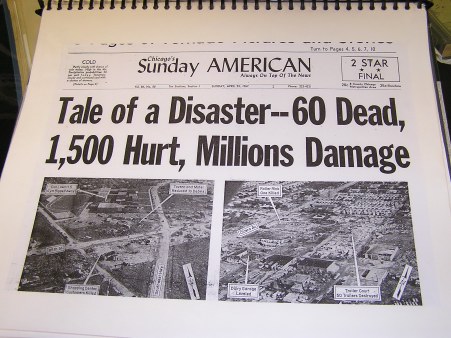
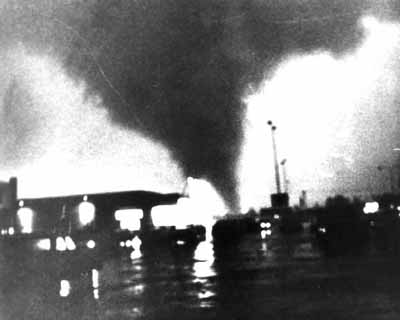
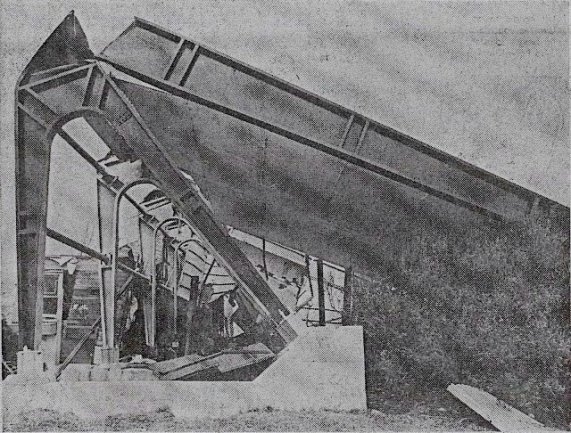

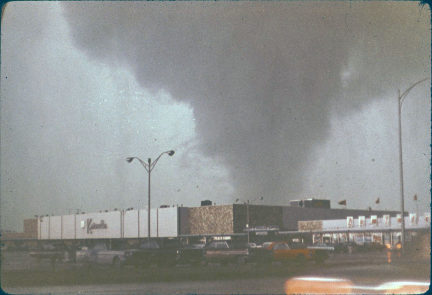
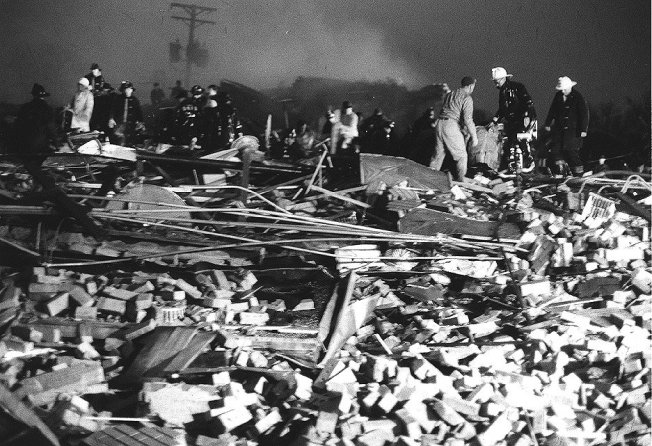
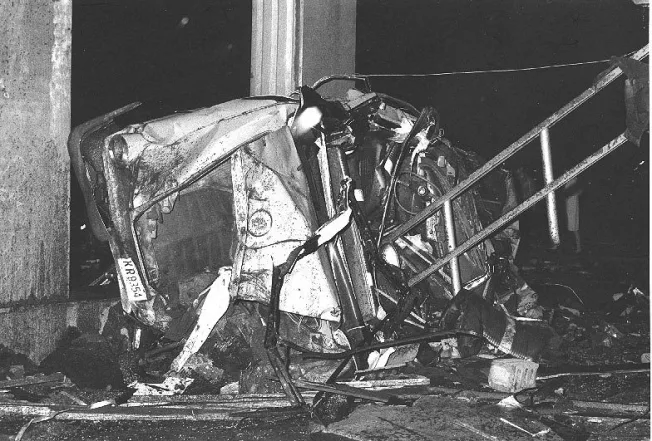
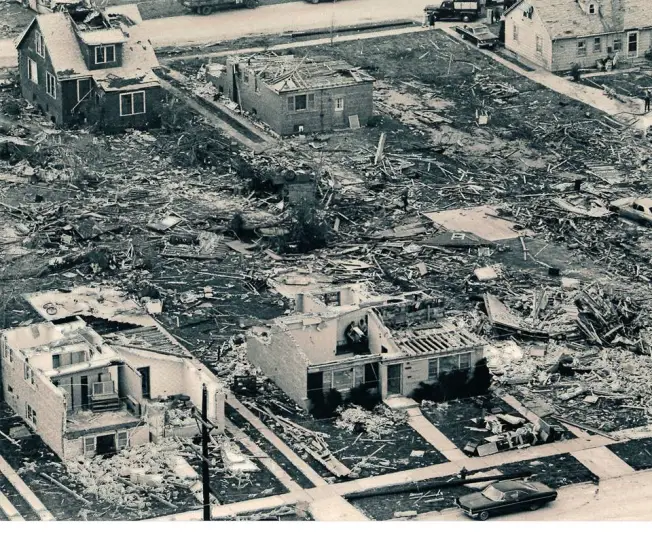
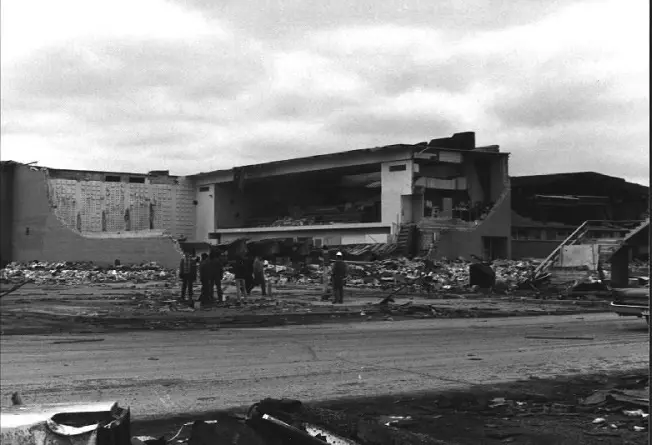
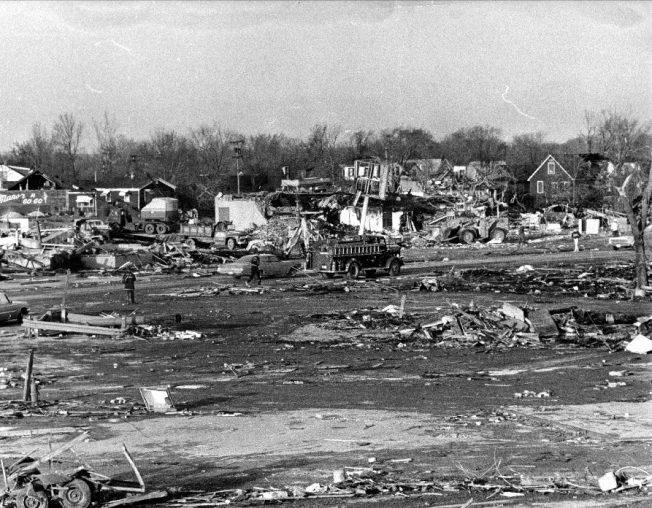
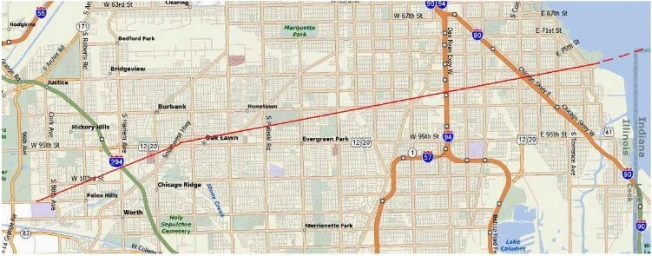
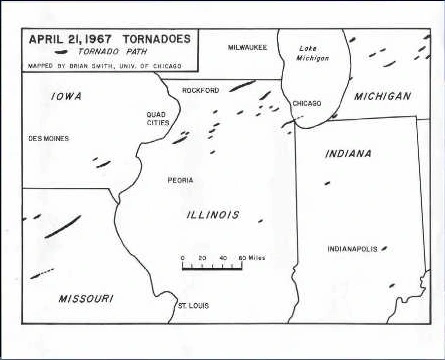
I honestly never would have thought reading about tornadoes could be so fascinating. Also note to self, do NOT hunker down in vehicle during tornado. Good grief!
Patrick Calascibetta was the next door neighbor to my parents. A very special man. He was traveling home with his Son when their car was hit by the tornado. God bless a good man.
You did a fine job on this event Mick. Kudos from a longtime ‘weather geek.’ 😉